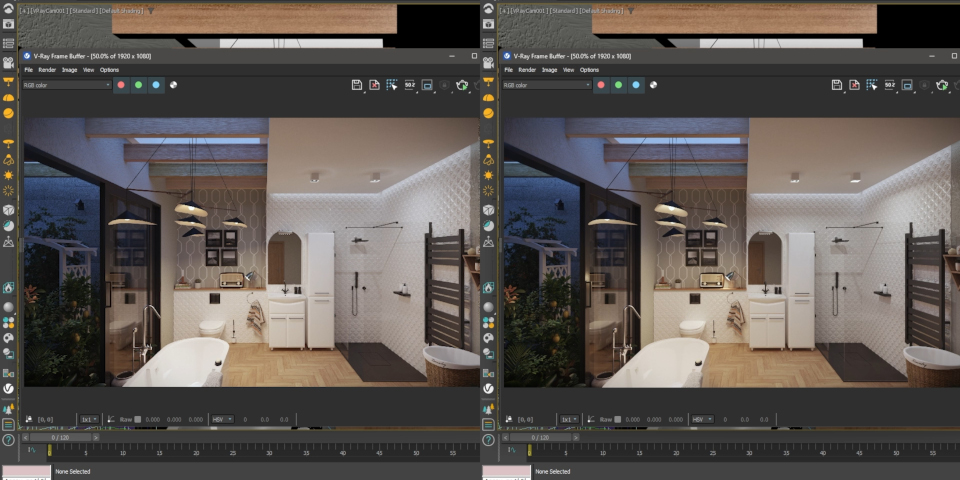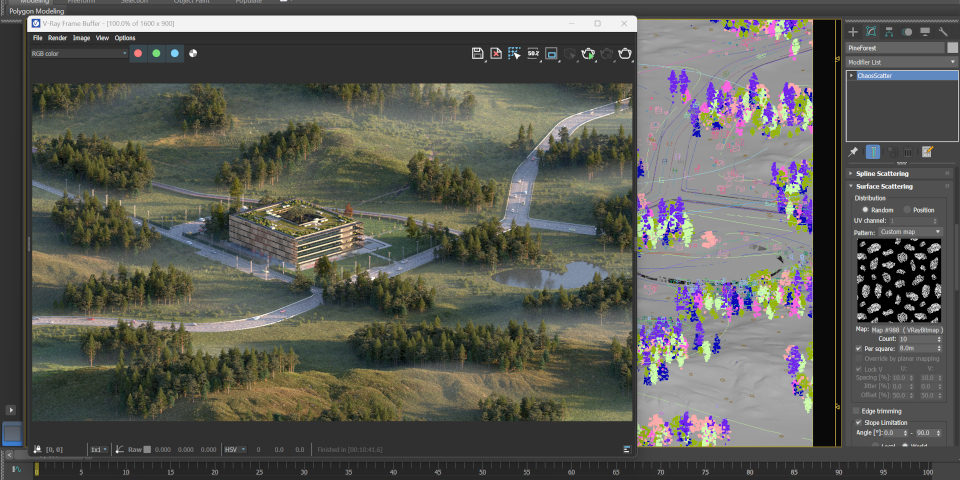Chaos releases V-Ray 7 for 3ds Max
Orignally posted on 2 October 2024 for the beta, and updated for the final release.
Chaos has released V-Ray 7 for 3ds Max, the next major version of the production renderer – and the first of the next generation of updates to the entire V-Ray product family.
The update adds support for rendering 3D Gaussian Splats, a new scene-profiling system, and features updates to V-Ray GPU, the V-Ray Frame Buffer and Chaos Scatter.
The first of a new generation of updates to the V-Ray product family
Chaos typically introduces new features in the 3ds Max and standalone editions of V-Ray before rolling them out the other versions, starting with V-Ray for Maya.
As a result, V-Ray 7 provides a glimpse not just of the new features for 3ds Max users, but of the next generation of releases for the product family as a whole.

Native support for rendering 3DGS scan data
New features in V-Ray 7 for 3ds Max include support for 3D Gaussian Splats (3DGS).
A new 3D scanning method, 3D Gaussian Splatting generates high-quality reconstructions of real-world objects or scenes from source photos or video.
Although there are free third-party add-ons for rendering 3DGS data in Blender, Unity and Unreal Engine, V-Ray is one of the first CG applications to support the technology natively.
Chaos tells us that it expects the functionality to appeal to both architectural visualization and VFX studios, particularly as a way of creating detailed background environments.
You can read a good overview of how 3D Gaussian Splats work, and the pros and cons of workflows based around them in this post on Chaos’s blog.

Lighting and rendering: V-Ray Luminaires and updates to V-Ray Sun and Sky
Changes to lighting and rendering in V-Ray 7 include support for luminaires.
Users can now import baked lighting data for real-world light fittings in .vlw format, making it possible to recreate the illumination they create more accurately in interior scenes.
In addition, the V-Ray Sun and Sky system has been updated to support the PRG Clear Sky model used in Corona, Chaos’s other major production renderer.
According to Chaos, it generates more realistic lighting effects than the previous model, particularly at sunrise and sunset, and when rendering the sky from greater altitudes.
The firefly removal algorithm, for removing bright flecks in renders, has also been updated.
V-Ray GPU: initial support for caustics
V-Ray GPU, V-Ray’s hybrid CPU and GPU renderer, gets initial support for rendering caustics, bringing it closer to feature parity with the main CPU render engine.
You can see a list of the remaining features not supported in V-Ray GPU here.
VFB: vignetting and freeform render regions
The V-Ray Frame Buffer (VFB), for viewing and editing images rendered in V-Ray, gets a new Vignette Layer, making it possible to apply vignetting effects to renders.
A new Filters tab applies readymade, non-destructive color correction presets.
The VFB also now supports freeform region rendering, making it possible to specify render regions of arbitrary shape to help resolve key areas of an image more quickly.

Updates to Chaos Scatter
Chaos Scatter, the object scattering system introduced in V-Ray 6, also gets an update.
New features include the option to use texture maps to control scattering, and a new Instance brush to paint in scattered objects manually.
Other new features
V-Ray for 3ds Max now includes V-Ray Profiler, the new tool for identifying performance bottlenecks in scenes introduced in the Maya and Houdini editions of the software.
It is currently only available in V-Ray CPU.
The release also features updates to the V-Ray Lister, and extends support for Open Shading Language (OSL). You can find a full list of changes via the link at the foot of the story.
Updates to Chaos Cloud and Chaos Cosmos
Outside the core application, cloud rendering service Chaos Cloud gets new functionality for creating virtual tours of 3D environments, complete with floor plans and minimaps.
Users can place Hotspots to act as navigation points in the environment for the viewer, and Highlights to provide text or image annotations for key details.
Chaos Cosmos, the online asset library now available with all V-Ray subscriptions, gets “hundreds” of new assets, including a new Luminaire category.
The library also now supports asset variants, making it possible to switch between variant looks for an asset without having to re-import it into the scene.
The variant system is initially being used for seasonal changes to trees and plants.
Subscription prices up since V-Ray 6
Chaos has also raised the price of V-Ray subscriptions since the previous release.
V-Ray Solo subscriptions now cost $84.90/month or $514.80/year, up $5/month or $48/year, and V-Ray Premium subscriptions cost $119.90/month or $718.80/year, up $24/year.
V-Ray Enterprise subscriptions are unaffected.
Price and system requirements
V-Ray 7 for 3ds Max is compatible with 3ds Max 2020+, running on Windows 10+.
The software is rental-only, with V-Ray Solo subscriptions costing $84.90/month or $514.80/year, V-Ray Premium costing $119.90/month or $718.80/year, and V-Ray Enterprise costing $598.80/year.
Read an overview of the new features in V-Ray 7 for 3ds Max on Chaos’s blog
Read a full list of new features in V-Ray 7 for 3ds Max in the online release notes
Have your say on this story by following CG Channel on Facebook, Instagram and X (formerly Twitter). As well as being able to comment on stories, followers of our social media accounts can see videos we don’t post on the site itself, including making-ofs for the latest VFX movies, animations, games cinematics and motion graphics projects.
